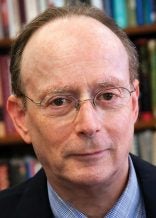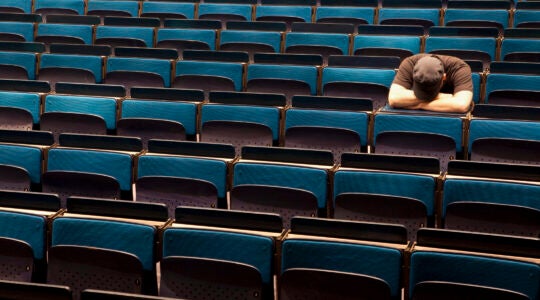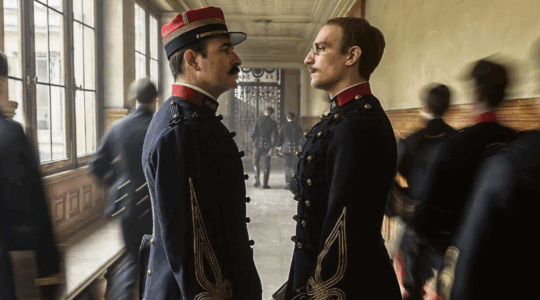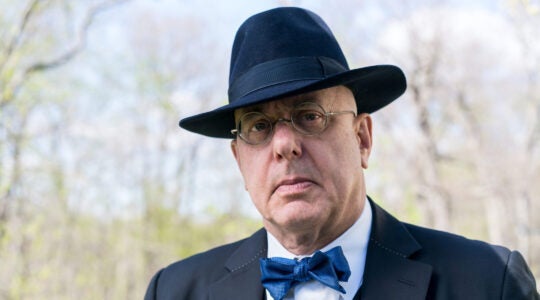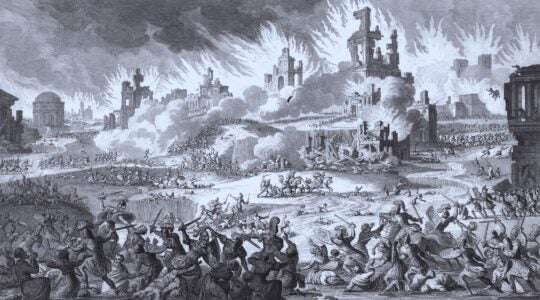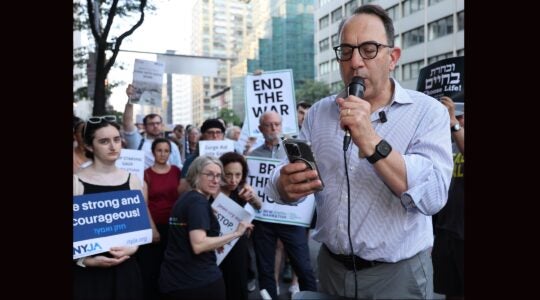A friend told me that when he mentioned to his young daughter last week that he was going to attend the White House Chanukah party, she looked up at him wide-eyed and said, “I didn’t even know President Obama was Jewish.”
For a couple of hours last Wednesday night in Washington, D.C., though, it seemed the whole world was Jewish.
The setting was the elegant grand foyer of the White House, bedecked with dozens of dazzlingly decorated Christmas trees. There, more than 500 invited guests, primarily Jewish lay and professional leaders and activists from around the country, mingled and shmoozed while dining on kosher lamb chops and traditional potato latkes. Then, when the evening’s hosts, the president and first lady, appeared in their midst, the assembled warmly applauded the president’s brief remarks. He summarized “the miracle of Chanukah,” pledged “unshakeable support and commitment to the security of the nation of Israel,” and called for “the value of tikkun olam to guide our work this holiday season.”
As I looked around the room at the smiling faces, nodding with approval, I wondered if this was the same president so many of us fear has lost his patience with the government of Israel. But in the moment, the joyful spirit of the festival and the dignified aura of the historic surroundings prevailed. The bitter political and religious divides that plague our people seemed to fade under the bright lights of the traditional chandeliers.
As a relaxed, at times jovial, President Obama noted in his remarks, “This is the second year we’ve invited so many friends that we ended up having to have two Chanukah parties.” (A similar event, with another 500 guests, was held a few hours earlier. Between the two celebrations, there were in attendance Jewish Supreme Court justices, members of Congress and key figures in the administration, as well as rabbis, heads of Jewish organizations and notables in a variety of fields.)
Surely we have come a long way, I thought. Indeed, that was the theme of the president in his remarks, as well as those of Rabbi Angela Buchdahl of Central Synagogue in Manhattan, who led the crowd in a spirited rendition of the Chanukah blessings as the menorah was lit. Obama described the “timeless story” of Chanukah as one “so powerful that we all know it by heart — even us gentiles. It’s a story of right over might, of faith over doubt,” reminding us “miracles come in all shapes and sizes.”
He announced with pride the release that day of Alan Gross, after five years under arrest in Cuba, and introduced Rabbi Buchdahl, who noted the fact that “tonight we, as a tiny religious minority, are able to celebrate our holiday with you in the White House is a miracle that we do not take for granted as the Jewish people. Our Founding Fathers aspired to build a country that was truly a place of religious freedom and equal opportunity for all people. But … they could not have imagined that in 2014 there would be a female Asian-American rabbi lighting the menorah at the White House for an African-American president. I think they’d be surprised. … This country is a country of miracles.”
Implicit in their remarks was that American Jews today live with more freedom than Jews have had at any time in history, and that Jews today are blessed to live in a world with a Jewish state for the first time in 2,000 years.
Diversity was on display everywhere one looked, with hundreds of Jews noshing kosher delicacies in rooms bedecked with holly, the U.S. Marine Chamber Orchestra playing both Christmas and Chanukah tunes, and dozens of yarmulke-wearing men davening at ad hoc mincha and maariv services over in the corner.
In the days before the event, when I mentioned to friends and family that I was planning to attend the White House Chanukah party, I was surprised that even those most critical of Obama seemed excited, even envious, of the opportunity. I guess there is something about The White House and the Office of President that transcends misgivings about the occupant at the time.
The most often asked questions were who gets invited and how? Matt Nosanchuk, former White House director of outreach to the Jewish community and now director of outreach on the National Security Council at the White House, told me the goal of the holiday receptions, which he plays a key role in planning, is “to be inclusive of the communities we’re inviting into the White House.” The fact that there are two “co-equal” Chanukah events “indicates the strength of the Jewish community in our public life, and it’s important to have broad representation.”
“We look for interesting, thoughtful leaders, pacesetters and key stakeholders in the Jewish community,” Nosanchuk explained. Some are invited each year. Others this year included academics, Nobel Prize winners, authors, Naval Academy midshipmen, the longest-serving Jewish chaplain in the army, people who played significant roles in the administration’s efforts on issues like climate control or immigration, and the director of the Kansas City JCC, where three people were shot and killed before Passover by a white supremacist.
On the celebrity front, the actress Gwyneth Paltrow stood with her daughter a few feet from me during the president’s remarks, as did the actress and songwriter Emmy Rossum. They seemed as excited about the presence of the president and first lady as the rest of the crowd. When Adam Levine was introduced at the podium, amidst a few shrieks from young women nearby, the president was quick to explain that it wasn’t Adam Levine, the heavily tattooed lead singer of Maroon 5, but Adam Levine the medical doctor and assistant professor of emergency medicine at Brown University’s medical school who recently returned from treating Ebola patients in Liberia. (Jewish nachas.)
Dr. Levine lit the menorah at the evening program; Rabbi Bradley Shavit Artson, vice president of the American Jewish University in Los Angeles, had been given the honor at the afternoon event. Each program featured a different menorah fraught with symbolism. One was made by students of the Max Rayne Hand in Hand (Yad B’Yad) Bilingual School in Jerusalem made up of Arab and Jewish students. (The school was set ablaze last month, allegedly by members of a Jewish extremist group, and left with anti-Arab graffiti on the walls.) The other menorah was made by children of Yemin Orde, a Jewish youth village near Haifa that is home to 400 youngsters from Ethiopia, Iran, India, Yemen, Eastern Europe and South America.
Nosanchuk emphasized that the Chanukah celebrations are not “ticketed events — they are receptions by invitation only. It’s not just about being deserving,” he said. “We’re trying to present a microcosm of the breadth and diversity of the Jewish community.”
By evening’s end I felt a swell of pride — American and Jewish, for my country and my people — in seeing the realization of our parents and grandparents’ dreams embodied in this symbolic celebration. In the words of the traditional blessings, we were expressing gratitude for the miracles performed for our ancestors and, in our day, for “allowing us to reach this moment.”
The New York Jewish Week brings you the stories behind the headlines, keeping you connected to Jewish life in New York. Help sustain the reporting you trust by donating today.
